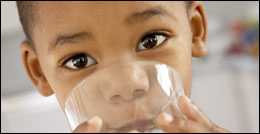Drinking Water Safety
This website is archived for historical purposes and is no longer being maintained or updated.
 The United States has one of the safest drinking water supplies in the world. However, each year, outbreaks of illness related to contaminants in drinking water are reported to the Centers for Disease Control and Prevention. People should know where their drinking water (tap or bottled) comes from, how it has been treated, and whether it is safe to drink. The quality of drinking water from the tap can vary depending on whether its source is a regulated water system or an unregulated small community system or private well. Home tap water may also be filtered.
The United States has one of the safest drinking water supplies in the world. However, each year, outbreaks of illness related to contaminants in drinking water are reported to the Centers for Disease Control and Prevention. People should know where their drinking water (tap or bottled) comes from, how it has been treated, and whether it is safe to drink. The quality of drinking water from the tap can vary depending on whether its source is a regulated water system or an unregulated small community system or private well. Home tap water may also be filtered.
Tap water from any system can be contaminated from
- chemicals and minerals that occur naturally, such as arsenic;
- viruses, bacteria, and parasites;
- local land-use practices, such as pesticide use;
- industry; and
- sewer overflow and failing septic systems.
The U.S. Environmental Protection Agency (EPA) regulates drinking (tap) water from large public water systems across the country. However, about one in seven Americans relies on private wells and small public water systems—systems that EPA does not regulate. People who rely on private wells for their drinking water are responsible for ensuring that their well water is safe.
Health and Safety Tips
- Know if your drinking water is from a private well, and, if so, test it for contaminants. (EPA)
- Know if you have a septic tank, and, if so, properly maintain it to prevent illness.
Important Links
- About Lead in Drinking Water
- CDC's Environmental Public Health Tracking Network data on Community Water.
- Healthy Drinking Water
- Drinking Water and Health: What You Need to Know! [PDF – 995 KB] (EPA)
- Water on Tap: What You Need to Know [PDF – 2.16 MB] (EPA)
- Private Well Water and Fluoride Frequently Asked Questions
- Local Drinking Water Information (EPA)
- Groundwater and the Rural Homeowner (U.S. Geological Survey)
- Page last reviewed: March 3, 2014 (archived document)
- Content source:
- Centers for Disease Control and Prevention


 ShareCompartir
ShareCompartir